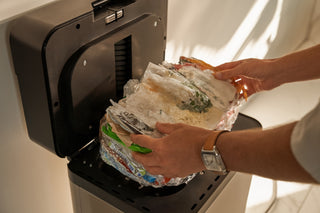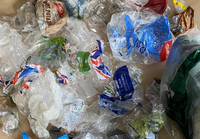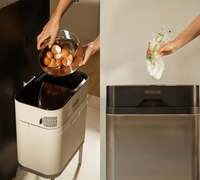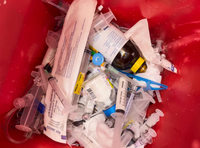U.S. healthcare produces more than 5 million tons of waste every year, and plastics account for a significant portion of it. While safety and sterility require single-use items, much of this plastic is still recyclable. This guide breaks down the main challenges and proven solutions that help hospitals improve soft plastic recycling and reduce operational waste. We also highlight technologies such as soft plastic compactors that make recycling more efficient in clinical settings.
5 million tons of plastic waste is generated in US healthcare annually
The healthcare industry, while vital to human well-being, is a significant contributor to plastic waste. From single-use syringes and IV bags, to sterile packaging, PPE, food packaging, regular business operations, and more, the sector relies heavily on plastic materials to ensure hygiene, patient safety, efficiency and convenience.
However, this reliance generates vast quantities of plastic waste – much of it non-recyclable due to contamination or mixed materials. According to a report by Healthcare Without Harm, hospitals in the U.S. produce over 5 million tons of waste annually, with plastics making up a substantial portion. To put it in perspective, 5 million tons is the equivalent of nearly 3 million midsize cars!
Given the environmental urgency, healthcare sustainability professionals are increasingly seeking ways to reduce plastic use and improve recycling within their facilities.
Here are six practical solutions that can make a meaningful impact:
1. Conduct a plastic waste audit
A comprehensive plastic waste audit allows healthcare facilities to understand the types and volumes of plastics being used and discarded. By identifying high-waste areas, sustainability teams can target specific processes or departments for improvement. For example, operating rooms are known hotspots for single-use plastics and can benefit from focused interventions. However, we must remember that plastic plays a critical role in modern healthcare, offering numerous benefits like improved sterility, durability, and cost-effectiveness. So it’s important to not instantly demonize plastic, but instead examine how its use can be reduced or how recycling the material can be improved. A good audit will provide insight into opportunities for any healthcare facility.
2. Switch to reusable medical supplies where safe

Many plastic products in healthcare are single-use for safety reasons, but some items can be safely replaced with reusable alternatives. Surgical instruments, gowns, and certain types of trays can be sterilized and reused. Hospitals should evaluate which plastic items could be replaced with reusable versions without compromising safety or compliance.
3. Implement recycling programs for clean plastics
While contaminated plastics are difficult to recycle, clean plastics—such as packaging from sterile instruments—can often be recycled. Establishing a system where staff can easily separate clean from contaminated plastics encourages recycling. Partnering with specialized recycling companies can also open new avenues for processing healthcare-specific plastics.
“As a research institute conducting studies on the impact of microplastics on human health, we analyzed how much non-contaminated plastic waste we were producing ourselves,” said Dr. Charlie Rolsky, Executive Director and Lead Research Scientist at the Shaw Institute in Blue Hill, Maine. “We couldn’t ignore the irony and decided to take action by evaluating how we can reduce that waste and also better ensure that as much of it is recycled as possible. We’re now working with suppliers that offer lower or plastic-free packaging, but we are also soon beginning a pilot program with Clear Drop to test their Soft Plastic Compactor device, which reduces the volume of the waste by about 90% – making it much easier for us to manage and also for recyclers to collect and process for re-use.”

How Healthcare Facilities Can Improve Soft Plastic Recycling
- Track and separate clean vs. contaminated plastics during disposal workflows.
- Install dedicated bins for sterilized packaging and other clean soft plastics.
- Compact soft plastics to reduce storage volume by up to 90% for easier collection and pickup.
- Partner with specialized recycling companies that accept medical-grade plastics.
- Empower clinical staff through sustainability education and clear visual guidance.
Many hospitals are piloting compacting technologies to improve recycling logistics. A soft plastic compactor helps keep recyclables out of biohazard waste streams and significantly reduces hauling frequency.
Make Soft Plastic Recycling Easier in Healthcare
Clear Drop® Soft Plastic Compactor (SPC) reduces the volume of non-contaminated plastic waste by up to 90% and prepares it for responsible recycling.
See how hospitals are integrating it into sustainability initiatives.
4. Source bioplastics and eco-friendly alternatives
The market for biodegradable and compostable medical products is growing. Items such as bioplastic syringes, eco-friendly bedpans, and compostable packaging can replace traditional plastic counterparts. Healthcare procurement teams can prioritize suppliers who offer sustainable alternatives to petroleum-based plastics.
5. Staff training and engagement
Sustainability initiatives succeed when staff across all levels understand their role in reducing plastic waste. Regular training sessions, visual aids near disposal areas, and recognition programs for sustainable practices help create a culture of environmental responsibility. Engaged staff are more likely to follow recycling protocols and suggest improvements.
6. Work with manufacturers for sustainable product design
Healthcare institutions can leverage their purchasing power to influence manufacturers toward more sustainable designs. This includes advocating for products with minimal or recyclable packaging, modular designs that reduce material use, or take-back programs where manufacturers reclaim used products for recycling.
“There’s no single solution to solving the problems that are related to plastic waste,” said Ivan Abrouzov, President and CEO of Clear Drop, Inc. “Whether it’s within healthcare or other industries, many factors have caused the issues we face, especially when it comes to recycling. It will only be through multiple solutions that we can begin to reduce waste, improve recycling and create what we like to refer to as a ZeroTrash® Lifestyle. Our technology and products are a step toward making that a reality. Whether it’s with our products or not, I encourage everybody to be part of the solution.”
Reducing plastic waste in healthcare is not without its challenges – safety, regulatory compliance, and cost all play a role in shaping what’s possible. However, by adopting targeted strategies and fostering innovation, the industry can significantly reduce its plastic footprint.
Collaboration between healthcare providers, manufacturers, and sustainability experts is essential for developing scalable, practical solutions that protect both human health and the environment.
Make Soft Plastic Recycling Easier in Healthcare
Clear Drop® Soft Plastic Compactor (SPC) helps hospitals and research facilities keep clean plastics out of biohazard streams, cut storage volume, and prepare soft plastics for responsible recycling.
Learn more about SPC for healthcare settings.
Frequently Asked Questions
Can hospitals recycle soft plastics like sterile packaging?
Yes. Clean and non-contaminated packaging such as plastic film and wrap can be recycled if it is separated from biohazard waste and routed into dedicated recycling streams.
How does a soft plastic compactor help?
It reduces the volume of plastic waste, making it easier to collect, store, and send to recyclers without increasing operational burden on clinical staff or facilities teams.
Do compaction solutions meet healthcare safety requirements?
Yes. Compaction is used only for clean, non-contaminated plastics and is designed to support existing compliance, infection control, and sterilization workflows.
What types of plastics are difficult to recycle?
Mixed-material products, contaminated PPE, and medical-grade plastics exposed to bodily fluids cannot enter recycling streams and must be disposed of as regulated medical or biohazard waste.























